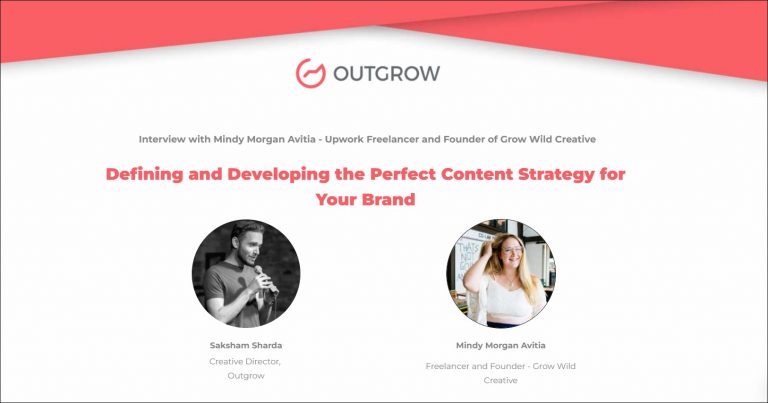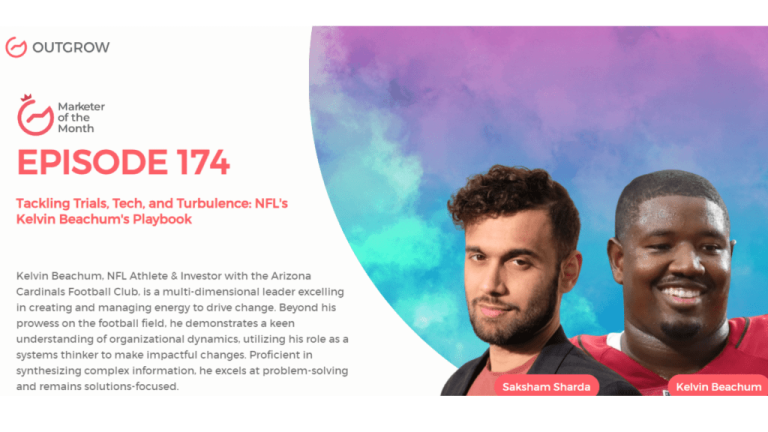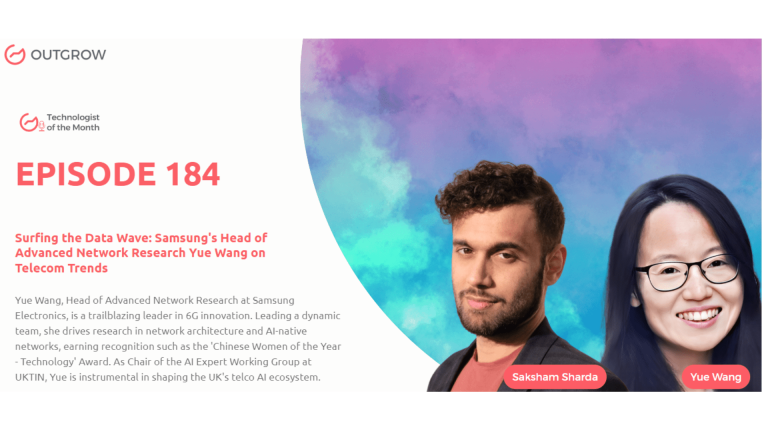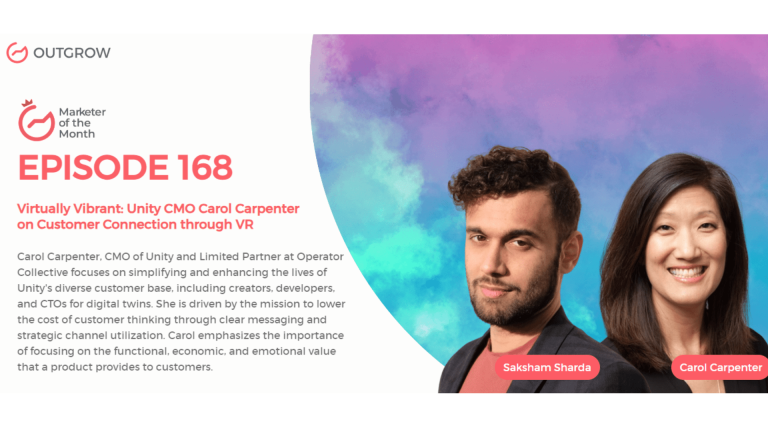EPISODE 104: Marketer of the Month Podcast with Eddie Shleyner
Table of Contents
Hey there! Welcome to the Marketer Of The Month blog!
We recently interviewed Eddie Shleyner for our monthly podcast – ‘Marketer of the Month’! We had some amazing insightful conversations with Eddie and here’s what we discussed about –
1. Challenges faced in starting Very Good Copy and growing its subscriber base
2. The evolving role of copywriters with AI technology
3. The potential of AI-generated content for personalization and persuasion
4. Benefits of teaching while learning to Copywrite
5. Balancing repurposed and original content
6. How Linkedin became a preferred platform to share resourceful content
About our host:
Dr. Saksham Sharda is the Chief Information Officer at Outgrow.co He specializes in data collection, analysis, filtering, and transfer by the means of widgets and applets. Interactive, cultural, and trending widgets designed by him have been featured on TrendHunter, Alibaba, ProductHunt, New York Marketing Association, FactoryBerlin, Digimarcon Silicon Valley, and at The European Affiliate Summit.
About our guest:
Eddie Shleyner, the founder of VeryGoodCopy.com, is a seasoned copywriter and content strategist with a decade of experience. He’s worked with top clients like Shopify and Adobe, and has been featured in Forbes and Inc. Eddie is also a popular speaker on content strategy and copywriting.
The Future of Copywriting – Challenges, Opportunities, and Strategies for Success
The Intro!
Saksham Sharda: Hi, everyone. Welcome to another episode of Outgrow’s Marketer of the Month. I’m your host, Dr.Saksham Sharda. I’m the creative director at Outgrow.co And for this month we are going to interview Eddie Shleyner, who is the founder at VeryGoodCopy.com Thanks for joining us, Eddie.
Eddie Shleyner: It’s my pleasure. Thanks for having me.
Don’t have time to read? No problem, just watch the Podcast!
Or you can just listen to it on Spotify!
The Rapid Fire Round!
Saksham Sharda: All right. So Eddie, we’re going to start with a rapid fire round just to break the ice. You get three passes, in case you don’t want to answer the question, you can just say pass, but try to keep your answers to one word or one sentence only. Okay?
Eddie Shleyner: Okay.
Saksham Sharda: All right. So the first one is at what age do you want to retire?
Eddie Shleyner: Never.
Saksham Sharda: How long does it take you to get ready in the mornings?
Eddie Shleyner: Couple minutes probably
Saksham Sharda: The most embarrassing moment of your life?
Eddie Shleyner: I don’t know.
Saksham Sharda: That’s a past then. Okay, favorite color?
Eddie Shleyner: Blue.
Saksham Sharda: What time of day are you most inspired?
Eddie Shleyner: Late night I think
Saksham Sharda: How many hours of sleep can you survive on?
Eddie Shleyner: Maybe six hours, I need my sleep. Yeah.
Saksham Sharda: Fill in the blank- An upcoming marketing trend is __________.
Eddie Shleyner: That’s hard. I can only answer in just one sentence or one word.
Saksham Sharda: Yes.
Eddie Shleyner: That’s tough. Social Media Optimization.
Saksham Sharda: The city in which the best kiss of your life happened?
Eddie Shleyner: Paris.
Saksham Sharda: Pick one Mark Zuckerberg or Jack Dorsey?
Eddie Shleyner: Jack Dorsey.
Saksham Sharda: The biggest mistake of your career?
Eddie Shleyner: Probably not starting copywriting sooner.
Saksham Sharda: How do you relax?
Eddie Shleyner: Hang out my kid.
Saksham Sharda: How many cups of coffee do you drink per day?
Eddie Shleyner: Maybe three.
Saksham Sharda: A habit of yours that you hate?
Eddie Shleyner: Biting my nails.
Saksham Sharda: The most valuable skill you’ve learned in life?
Eddie Shleyner: Direct marketing.
Saksham Sharda: And the last one is your favorite Netflix show?
Eddie Shleyner: Madmen when it was on Netflix.
Saksham Sharda: Well, let’s say you only had one pass. So that’s 9/10 which is amazing.
Eddie Shleyner: People usually pass more?
Saksham Sharda: They do here and there sometimes they’re not watching Netflix so they can’t answer a Netflix show. So then we go on to like Amazon Prime show or some of the shows.
Eddie Shleyner: That one about the most embarrassing moment, that’s tough.
Saksham Sharda: It is because you also don’t want to like, say the most embarrassing moment because it’s a podcast. Why would you tell everyone?
Eddie Shleyner: And also, I’ve had so many
Saksham Sharda: People have said that, as an answer to this, I’ve had so many. One person just answered saying, “This is my most embarrassing moment. Right now here.”
The Big Questions!
Saksham Sharda: Okay, all right. So let’s go on to the long-form questions. The first one is what are some of the challenges you faced when starting very good copy? And how did you overcome them to grow your subscriber base to 250k+ is that what it is right now?
Eddie Shleyner: Yeah, something like that. Well, I mean, it wasn’t a huge challenge is just kind of like getting into the flow of creating just like sitting down and writing every single day and being. Yeah, just cultivating that habit. I mean, that was never that didn’t come naturally. I think that over time evolved and became easier. And now it’s almost kind of like an unbreakable habit almost like a draconian thing that I have to do. But in the beginning, especially when I started kind of liked pursuing it in earnest. That was difficult for me because you know, just like anything else, there’s that resistance there you know, that resistance to sitting down and doing it, you know when that muscle isn’t formed yet. So yeah, I think that was the first part of your question, right?
Saksham Sharda: Yeah, so what is the habit? Like when do you wake up in the mornings and write for a while? I don’t know whether you’ve read the book, Atomic Habits.
Eddie Shleyner: Yeah. Well, I woke up. Now a lot sooner since I and my wife had a kid, so he’s 19 months old now. So for the last 19 months, I’ve been waking up, probably around six o’clock. Whereas I wasn’t waking up that early before I was kind of a night owl, and I was doing a lot of work at night. And I would kind of sleep in but yeah, I’ve been waking up, probably around six 630. Taking care of him and doing our morning routine together. And then, you know, I’d sit down and write for a few hours, try to do it interrupted. So yeah, that’s the morning routine so far.
Saksham Sharda: And are mornings the most productive for writing you reckon?
Eddie Shleyner: I guess right now they are, yeah. Because like, I think when you set a time for yourself to write, and you say, “Okay, I’m going to focus on this for the next two hours, you put your phone away, you create a blog for yourself on your calendar, and you just give yourself that focus time, you kind of hit a stride.” And then like, the more you focus, the more focused you become, if that makes sense. And the more productive you become in turn. So yeah, I guess, mornings have become the most productive for me on a consistent basis, but every now and then, you know, I’ll be on the couch. And I’ll kind of get bored of whatever I’m watching, or it’ll give me an idea. And, you know, I’ll pull on my phone, and I’ll start writing. And then who knows, sometimes I write a few articles, while I’m just sitting on the couch. Just kind of happenstance, you know, it comes out. And then I use the next day to kind of edit it, though, edit those pieces and clean them up and make them right. So it is strangely like, nighttime is still the most creative time for me. And when I say creative, I mean, like, I’m just better at making connections, you know, putting disparate things together in a flush way. But then the morning time is really good for, you know, that dedicated work, where I could sit down and just, you know, focus focus on the task at hand, which isn’t always the case at night.
Saksham Sharda: So what are some of the highlights of getting to that 250k level of subscribers?
Eddie Shleyner: Some of the highlights, I guess, talking to you. It’s cool to be on here. You guys have a marketer of the month. So there are only 12 of these a year.
Saksham Sharda: No that started as a monthly thing, but now there’s more.
Eddie Shleyner: I wasn’t gonna say Yeah. Listen, I think this has been a really strange thing that’s happened in my life. I never really expected folks to read my work or to subscribe to anything that I put out there. So I think just the idea that my work is reaching people and people are benefiting from it, but it’s helpful to them. I think, intrinsically that’s cool to me. It’s just very valuable to me intrinsically, just knowing that I’m making that kind of an impact or an effect.
Saksham Sharda: And speaking of impact, then do you think the role of copywriters in the industry will evolve as AI technology becomes more sophisticated and more widely available?
Eddie Shleyner: Well, I think evolve is a broad kind of way to put it. But yeah, certainly I think AI is a fantastic tool for copywriters for any creative person. Because AI helps you get started. It helps you put the pieces together. You know, I think of AI from a copywriting standpoint, I think of AI as kind of like, you know, at an agency, you know, Creative Director hires, Junior copywriters, juniors folks that are just getting started embarking on their creative career. And they say, “Hey, bring me 50 tags for this campaign, or bring me 50 ideas for this product”. And then the onus is on the creative director to extract the best ideas or to extract the best pieces of that and to focus the copywriter’s attention on those ideas and say, “Hey, we have something here. This is interesting. Let’s evolve this, yeah, let’s develop this.” And so in a way, that’s what AIcano do. Now you can plug it into, you know, you can pull your prompt and say AI and say, “Hey, give me 50 tags for this campaign give me 50 ideas for this product”. And then the onus is still on the human, it’s still on the individual to say, this is a good direction. This is a good way to go. Let’s focus here and develop this. So I think if anything, it’s just going to make work faster, make starting easier, and give you a broader kind of ideation process, you know, give you more to kind of work off.
Saksham Sharda: So there’s no danger of copywriters running out of jobs?
Eddie Shleyner: Well, I think that AI will replace some writing. I don’t necessarily think it will replace writers, you know, I think some writing stride and kind of shallow on its face. You know, if you’re doing product descriptions, for example, on Amazon, or if you’re doing, you know, anything that doesn’t involve a lot of connective kind of pieces, then yeah, maybe those jobs, so to speak, or that type of work will become kind of phased out. But I don’t think that there’s a chance that it’ll completely replace a human copywriter you still need that individual there to like I said before, focus your attention on the best direction, the best idea. So, yeah, it’ll replace writing, but it won’t replace writers. That makes sense.
Saksham Sharda: And in your journey, can you talk about the benefits of teaching as your lawn and how it helps you improve as a copywriter?
Eddie Shleyner: Well, of course, look, VeryGoodCopy started as a way for me to learn copywriting a way for me to develop my own. Developing this discipline, you know, when I started VeryGoodCopy, I was reading a lot of copywriting books, I was listening to a lot of copywriting podcasts, I was studying the greats. And whenever I would come into a technique, or a principle, or a concept that I found compelling, I would say, “Hey, if I could put this into words, if I could write about this in a clear and concise and engaging way, hopefully, then I’m ready to use this technique or principle or concept in my promotions”. And so you know, that was the evolution that was kind of the beginning of having a very good copy of VGC. And, you know, so it’s so real, I’m learning along with my readers, I’m learning along with my audience. You know, as soon as I learn something new, I share it with them. And we all kind of work together. So it’s part and parcel I see them as intricately linked. And yeah, I recommend that to anybody that wants to grow an audience, but at the same time, also, you know, learn we’re in a craft, we’re in a discipline because it’s how I learned for sure.
Saksham Sharda: So what are some of the more exciting things you’ve learned this year from your audience?
Eddie Shleyner: Well, from my audience, I mean, I don’t know.
Saksham Sharda: It could just be a story about something exciting. It doesn’t have to be something you learned, you know, something exciting, you ran into while interacting with the audience or anything.?
Eddie Shleyner: Well, no, I’ll answer your original question. I mean, I think what’s been most compelling about this entire experience for me, is realizing how similar we all are, in a way, you know, how bonded and how linked, we are by the human condition, you know, because when I write my micro articles, and when I publish stuff at VeryGoodCopy, you know, I’m teaching copywriting principles and teaching creativity principles. I’m teaching techniques around these things. But I’m always framing it in personal stories about myself, about my family, my wife, and son are huge muses for me about experiences that I’ve had stories, anecdotes that I’ve come into, I try to frame those lessons in these stories and share them and so they come out feeling very personal, because in a way they’re about me, kind of, you know, living my life and growing as a copywriter and as a person. And I found that a lot of people in my audience relate to it because, when I write about m when I read about my son, they don’t necessarily see my kid, they see their kid, you feel me, like when I read about my wife, they’re not necessarily seeing my wife in their mind. They’re seeing their partner, their husband or their wife, or their spouse. And that’s been interesting to me, not just this year, but in general. You know, my audience is very much like me, and I’m sure your audience is very much like you, you know, we’re all the same. We’re all kind of bonded by the human condition. So that’s been a really interesting part of this whole experience. And that’s something I necessarily really expected.
Saksham Sharda: Earlier you mentioned a couple of copywriting greats had inspired you and you’ll learn from who are some of the people you look up to in this marketing copywriting world.?
Eddie Shleyner: There are so many. I mean, when I first started it I was reading a blog by a guy called Gary Halbert, who is, you know, “copywriter’s-copywriter”. If you Google copywriting you’re gonna come up with GaryHalbert’st work and yeah, I found his stuff online, he had a brilliant newsletter. It was a print newsletter that he would send out to folks in the mail. And I think since then his son had digitized it. And so now it’s online. So if anybody listening to this typing Gary Halbert, you’ll find his newsletter. That was a real turning point for me because it introduced me to this concept of direct response, copywriting, this notion that, “hey, you can write something and compel people to take an immediate action, which was something that all of us have experienced, but kind of a novel idea for me”. So I would say yeah, if I had to kind of like pinpoint isolate one person, it would be Gary Halbert. But I mean, there are so many that I’ve learned from over the years, Joe Sugarman is another classic direct-response copywriter. He had a book called The Ad Week copywriting handbook, which I read, front to back one day changed my life changed the way I saw my career going. And I still revisit that book every year. I’ll go back and I’ll read it one time. Because it’s so overwhelming in its completeness. It’s just so rich in wisdom about this discipline. So that’s another good one.
Saksham Sharda: All right. So let’s talk a bit about repurposing. Now, how do you balance repurposing content from your LinkedIn micro interviews and micro articles with creating original content for your website and newsletter?
Eddie Shleyner: Well, I think first it’s the other way around, it starts on my starts on VeryGoodCopy.com. So I’ll publish everything on VeryGoodCopy.com. And then I kind of repurpose it for a new audience on LinkedIn. So that’s pretty simple. I publish on VGC and then I say, Okay, I’m going to put this on LinkedIn as well. And then I’m going to have, you know, a link, going back to my website, you know, the CTA might say, “Hey, if you like this, this article, I’ve written hundreds more, publish them all, for free, a VeryGoodCopy.com, feel free to check it out.” And then people go there, if they like what they see, they subscribe to the newsletter, which is really what the website is designed to do, I would say, probably 90 to 95% of the CTAs. VeryGoodCopy.com is designed to get people into the newsletter, and then I’ll send out, you know, every week, I’ll send out a new article to that newsletter, and I’ll link it to a post with the same copy on LinkedIn. And so it becomes this kind of virtuous cycle where I publish something on VeryGoodCopy, then I publish it on LinkedIn, then I take the URL from that LinkedIn post, put it into the newsletter. Somebody can click the CTA, and they just keep on going around round circles and it creates a group.
Saksham Sharda: Are there any other channels on which you are also sharing besides LinkedIn?
Eddie Shleyner: I mean, you know, I have a Twitter account, but I think I’m focusing mostly on LinkedIn. In part because it’s, you know it’s a lot of work, it’s a time suck, and I just don’t have time to be everywhere all at once. And everything is everywhere all at once. However, it’s Yeah, I don’t have to do it. It’s I think there’s also like, a huge benefit in focusing on one audience focusing on one platform, you know. And so yeah, so I do posts on Twitter from time to time, but I would say LinkedIn is my primary means to get people into the newsletter.
Saksham Sharda: So what do you think of LinkedIn as becoming this prime platform for marketers? In this, let’s just say half a decade because it was quite dead until like 10 years ago, I would say, but it’s kind of skyrocketed and overtake let’s say Facebook as to where people go and like, do this stuff.
Eddie Shleyner: If that’s true, I love it. It’s fantastic. And there, I think it’s great. I think that as long as you’re in earnest providing value and being helpful to people, there’s nothing wrong with wherever it is you’re doing it online. If you’re providing good information to people and helping them do their work better, or helping them live a better, more efficient, or more productive life, why not? So I think it’s great that there’s this influx of people posting on LinkedIn, being helpful on LinkedIn, supporting one another on LinkedIn, that’s important as well because you got to remember that it’s not just you, it’s a community of people. So I think it’s great, keep coming.
Saksham Sharda: So let’s talk a bit about your approach to client work. And how do you ensure that your copy resonates with their target audiences?
Eddie Shleyner: Well, there’s a rule in direct marketing, it’s called the 40-40-20 rule. They say 40% of any direct marketing campaign depends on the market, you know, are you putting this campaign in front of the right people? The other 40% is the offer. So are you compelling people with the right offer or what? You know, what’s in it for me, essentially? Are you answering that question? Well, and creating urgency. And the remaining 20% is creative, you know, and that’s several things that are copied. That’s art, that’s formatting. So the most important thing that you can do is understand the market. First and foremost, who is this campaign for? Who is this product or service for? And, you know, what are these people desperately wanting Because that’s going to inform your offer? So, yeah, to answer a pretty complicated question, simply, I would say, doing as much research as much understanding,g and trying to understand that market as much as I can. That’s probably the most important thing that you can do as a copywriter.
Saksham Sharda: And do you have any tips for organizations so that they know how they can create a culture of content creation within, you know, their employees? And how do they motivate employees to contribute their ideas and insights?
Eddie Shleyner: Within a company, I mean, yeah. I mean, it’s that’s a little out of my purview. Not exactly in my wheelhouse. But I think that if you want to first and foremost, you have to let people know that. They’re what they know, their talents, their skill sets are inherently valuable to people, you know, a lot of people are so close to their knowledge, and so close to their skill sets, that it becomes kind of, they feel self-conscious about sharing it, because they’re like, Oh, well, everybody knows how to do this, you know, I’ve been doing this for 10 years, they’ve been doing it for 10 years or 15 years, or however long, and they’re so so familiar with it, it’s hard to kind of break out of that curse of knowledge, and realize that, hey, there are other people that don’t know the first thing about this. And if they did, you know, they could do their work better, more efficiently, more productively. So I think, first and foremost, you have to encourage people that way and say, “Hey, you know, whatever it may be, is valuable to somebody out there.” So, don’t think that there’s anything that there’s any tidbit, any tip what have you that’s too small to share, you know, go ahead and share it. Because there’s bound to be somebody that’s going to find it valuable. That was always really surprising to me is like, I was so close to copywriting. I was so close to what I was doing. That I felt like I constantly had to be dropping this kind of groundbreaking wisdom on people were really, which wasn’t always necessary. You know, it was just necessary to kind of package it up in a digestible way. Even if it’s something little. And speaking of something little, you know, you mentioned James Clear-Atomic Habits. You know, I think one of the big premises of that book is that you have to start small, you know, if you want to cultivate a habit of I don’t know flossing your teeth, you know, don’t floss every single tooth just say “hey, I’m just going to floss one tooth filming or I’m just going to floss these two teeth today.” You know, you’re probably going to floss all of them anyway, but like, the point is, if you want to cultivate a habit of doing something, start with the smallest possible step. And maybe the smallest possible step on LinkedIn is instead of posting, your comment, you know, where you just go on there and you like, you offer a little bit of information to a very small portion of an audience, and then you grow from there.
Saksham Sharda: And are there any companies that have do you think their culture has managed to do this? Well, or would you say that’s outside your purview, too?
Eddie Shleyner: Well, I know that I think Gong does an excellent job. I worked with a content marketer there, he ran content marketing, and Gong, his name is Devin Reed. He was just fantastic at sharing what he knew about sales, writing about marketing, and tying it back to Gong the platform. And I think that a lot of people followed his leader Gong. And there’s a lot of people a gong now that are sharing their knowledge, their wisdom, in their respective disciplines. And so I think Gong is a good example. I think there are plenty of others. But that’s the one that kind of pops up at the top of my mind.
Saksham Sharda: Speaking of your own company, then can you talk about any upcoming projects or initiatives that you’re excited about? And what your goals are for the future, VeryGoodCopy.com. and your career in general?
Eddie Shleyner: Sure. Well, I released a course recently. It’s called a transformational landing page. It’s all about my ethos, my approach, and my system for creating landing pages. So that was exciting. I have a book coming out soon. So there’s a waitlist for that. And, I think, yeah, I think moving forward, I’d like to start doing more projects like that creating more products, that you know, you make it once, and then you scale it, more educational products, courses, books, etc. But I don’t think I’ll ever really stop doing client work, I think I’ve pared it down a little bit and tried to focus on other things. But client work is a really important part of my process, at least because I think it keeps you sharp, it keeps you just keeps you sharp, you know, when you have new problems to solve consistently, it just helps you use that muscle, instead of letting it atrophy. So I think that the future for VGC is more products, more books, and more courses. But also, when the right project comes around, I’d love to take that on to
Saksham Sharda: The last question for you is of a personal kind. What would you be doing in your life if not this right now?
Eddie Shleyner: Man, not VeryGoodCopy. That’s so hard. Because it’s been such a big part of it.
Saksham Sharda: Interestingly, you say not VeryGoodCopy because that could also be a website, not VeryGoodCopy.
Eddie Shleyner: I don’t know who was it. Yeah, I don’t know, man. I mean, I’ve always wanted to be a writer, I was an English major in college. So I studied literature and narrative. So you know, writing has always been a part of my life. And I’ve always wanted it to be a part of my life. And I kind of shudder at the thought of not being able to do it. But I would imagine I would probably do something ancillary. Or parallel to it, you know, maybe something in sales or something. Something where I’m still interacting or engaging with markets, you know, big groups of people that have the same common need or desire. I just shudder at the thought of not having, you know, a career in writing because I love it so much.
Let’s Conclude!
Saksham Sharda: All right. Well, that was the last question. Thanks, everyone, for joining us for this month’s episode of Outgrow’s Marketer of the Month. That was Eddie Shleyner, who is the founder of VeryGoodCopy.com. Thanks for joining us, Eddie.
Eddie Shleyner: I appreciate you having me, man. Thank you so much.
Saksham Sharda: Check out their website for more details, and we’ll see you once again next month with another marketer of the month.









